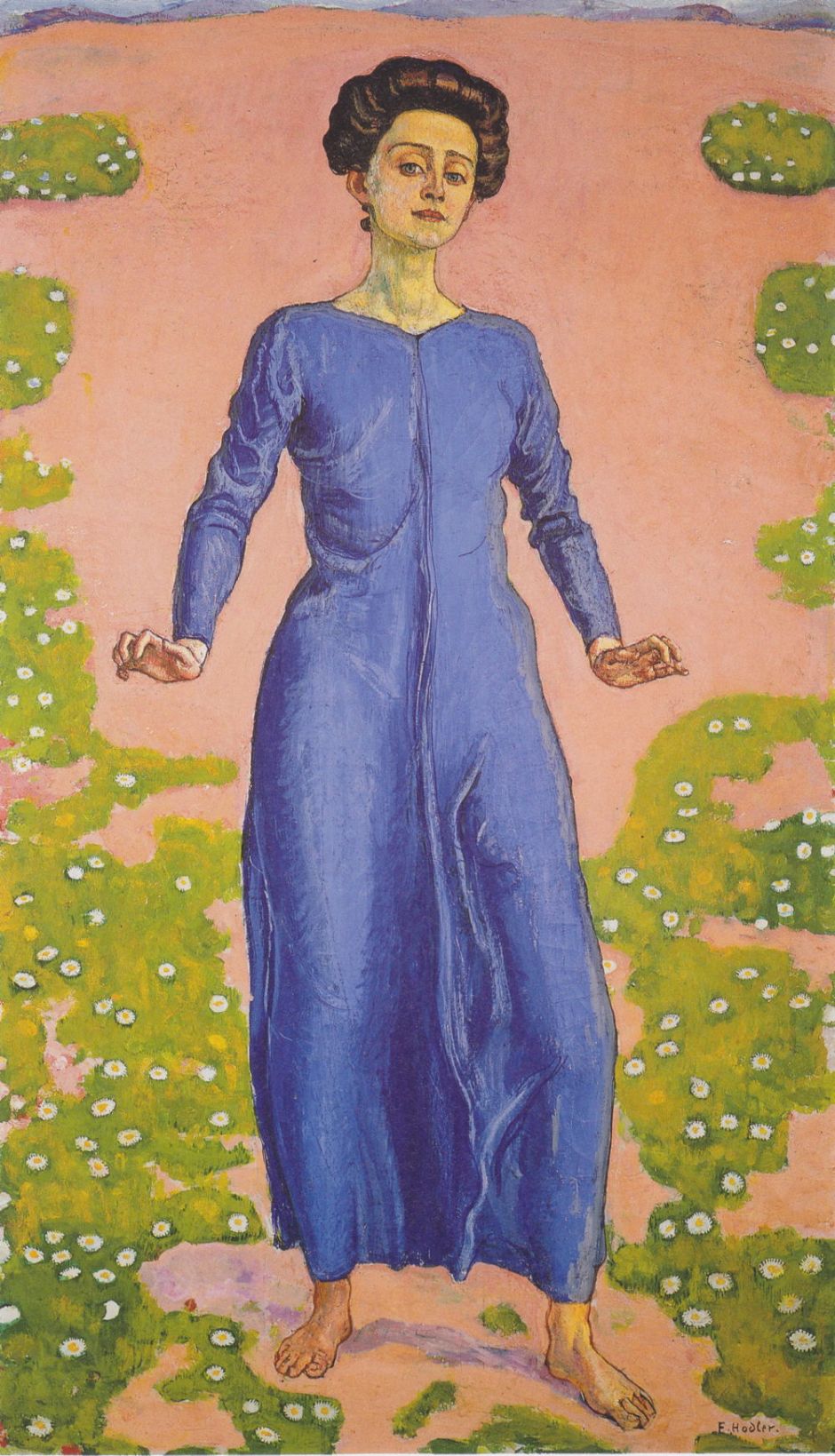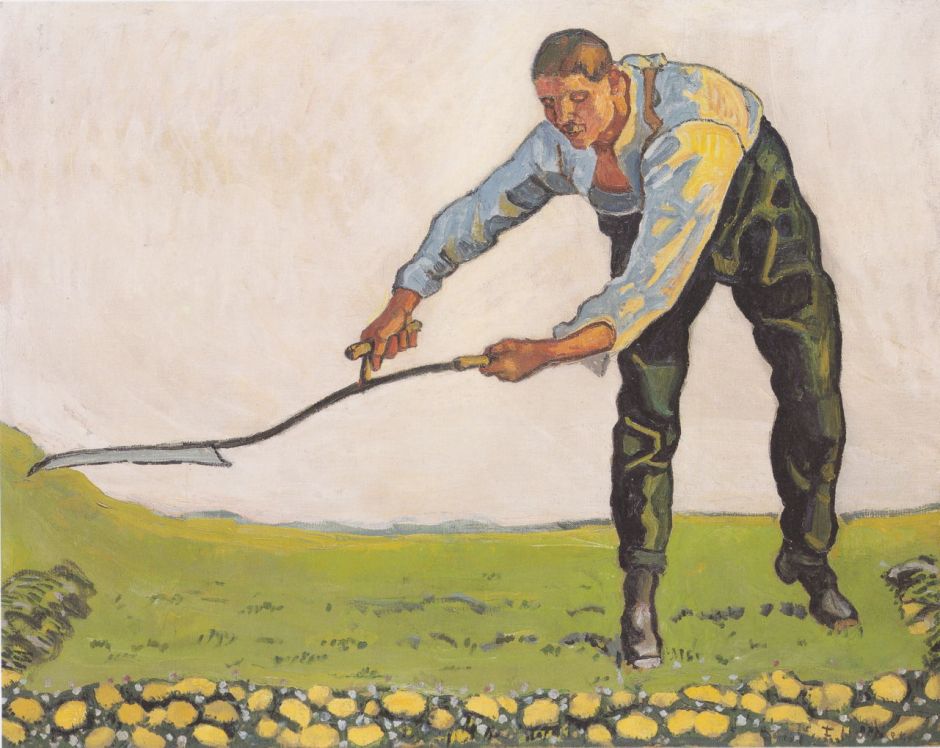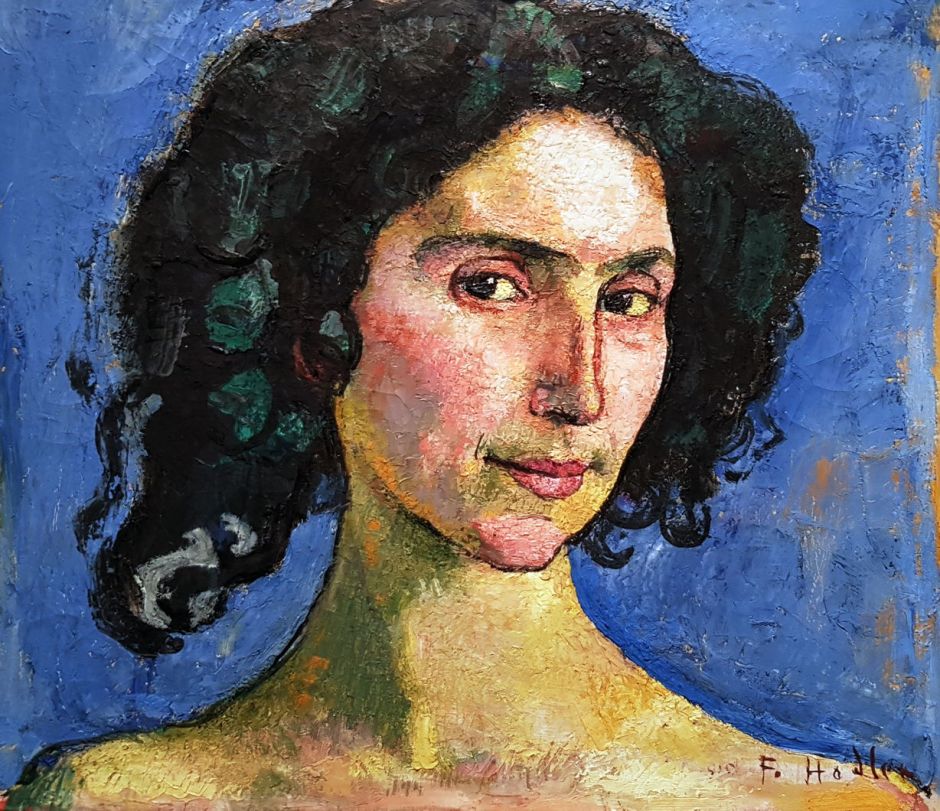In the years before the First World War, Ferdinand Hodler still found time between commissioned murals and other major figurative works to develop his landscape paintings.

Painted in about 1906, Landscape at Lake Geneva continues his previous realist style, with considerable detail throughout the depth of the painting, from the flowers of the meadow in the foreground, to the textures of the distant mountain ridges.

Transfiguration (c 1906-07) shows a similar motif to that in Song from Afar (1906), with the same model in a similar blue dress. However, this is more closely-cropped, and instead of her arms being held out, as if pushing away, they point downwards.
In 1907, Hodler was commissioned to paint another large mural, this time for a new university building in Jena, showing the departure of students from Jena to the War of Independence against Napoleon, in 1813.

Spring (1907) is a further version to the first from 1901, in which there have been small changes in the rendering of the two figures, and the background has changed completely to become a dense mass of yellow flowers.

Aareschlucht (1907) shows a spectacular gorge in the Bernese Oberland region of Switzerland, where the River Aare carves its way through a limestone ridge for about a mile. Its cliffs rise to 50 m (over 150 feet) above the bottom of the gorge, and it is not far from the Reichenbach Falls, which Hodler had painted at the very start of his career, in 1871. A walkway was constructed along the gorge between 1887-1889, but Hodler chooses to show the gorge from above.

Evening Mist on Lake Thun (1908) is an early and clear example of Hodler’s late reduction of landscapes to their basic elements of form, colour, and light – a radical change from his previous emphasis on detail, and a marked contrast from Landscape at Lake Geneva above.

This reduction is visible in this superb view of the Eiger, Mönch and Jungfrau in Morning Sun, which he also painted in 1908. Although the Eiger Massif is depicted faithfully, Hodler instills rhythm into the wispy clouds in the foreground. He also painted a companion view in moonlight which has more marked symmetry and rhythm.

One of the clearest examples of Hodler’s Parallelist landscapes is his Rhythmic Landscape on Lake Geneva from 1908. This was a second version of a view which he had previously painted in 1905, when he wrote “This is perhaps the landscape in which I applied my compositional principles most felicitously.”
Most of his symmetry and rhythm is obvious; what may not be so apparent are the idiosyncratic reflections seen on the lake’s surface. The gaps in the train of cumulus clouds here become dark blue pillars, which are optically impossible, but are responsible for much of the rhythm in the lower half of the painting.
In the Spring of 1908, Hodler met Valentine Godé-Darel (1873-1915), a Parisian, who modelled for him at first, then became his lover, and an important figure in his later work. In the autumn, he was commissioned by the Swiss National Bank to produce designs for its banknotes, which he based on versions of his next major figurative works, The Woodcutter and The Reaper.

Hodler painted several versions of The Woodcutter (1910), above, and its pendant The Reaper (1910), shown below, before he could select those on which the banknotes were based. In both he has all but eliminated the distractions of his earlier paintings of similar figures, and placed emphasis on the form and movement of the figures as they work with their traditional tools at age-old tasks.

In 1910, Hodler was commissioned to paint a mural for the staircase of the Kunsthaus in Zurich, which he based on A View to Infinity (three versions to 1905).

Between about 1910-11, Hodler was fascinated by an Italian singer, guitarist and dancer, Giulia Leonardi. She played regularly in a café in Geneva, where they first met. Hodler painted a series of portraits of her, of which Portrait of the Dancer Giulia Leonardi (1910), above, is perhaps the finest, with its carefully-worked skin tones and colours, and her coquettish look.
A second Portrait of Giulia Leonardi (1910) is shown below.


In the summer of 1910, Hodler was again busy painting landscapes in the Bernese Oberland. In Lake Thun with the Stockhorn Range (1910), he is on the north-eastern side of the lake, probably not far from the town of Thun, looking to the south-west over the lake at the Stockhorn and its lofty ridges.

For this view of the Eiger, Mönch and Jungfrau from Beatenberg (1910), Hodler moved along the shore of Lake Thun, up to the small town of Beatenberg. He then looked to the south-east at the Eiger Massif, with the eastern end of Lake Thun in the foreground. The Lauterbrunnen road then passes from left to right in front of the Eiger and Mönch.
His style has become significantly more gestural, with white marks resembling lettering on the foothills on the far side of the lake. The peaks themselves have been rendered in simplified form even when compared with his view in the morning sun from just two years before.
The Eiger is notorious for its challenging ascent by the north face, which is that shown here and in the previous view. Although the mountain was first climbed in 1858, the route up the north face was not accomplished for another 80 years, and unsuccessful attempts continue to result in deaths. It rises to an altitude of almost four thousand metres (13,000 feet), of which three thousand metres (over 9,000 feet) are from the surface of Lake Thun.
Reference
Hans-Peter Wipplinger (ed) (2017) Ferdinand Hodler, Elective Affinities from Klimt to Schiele, Leopold Museum / Walther König. ISBN 978 3 96098 220 3.

